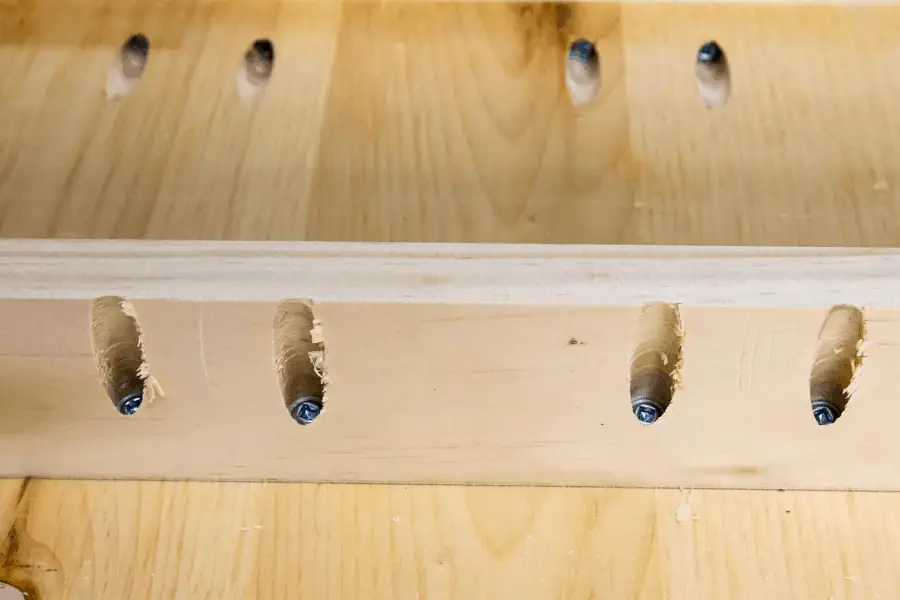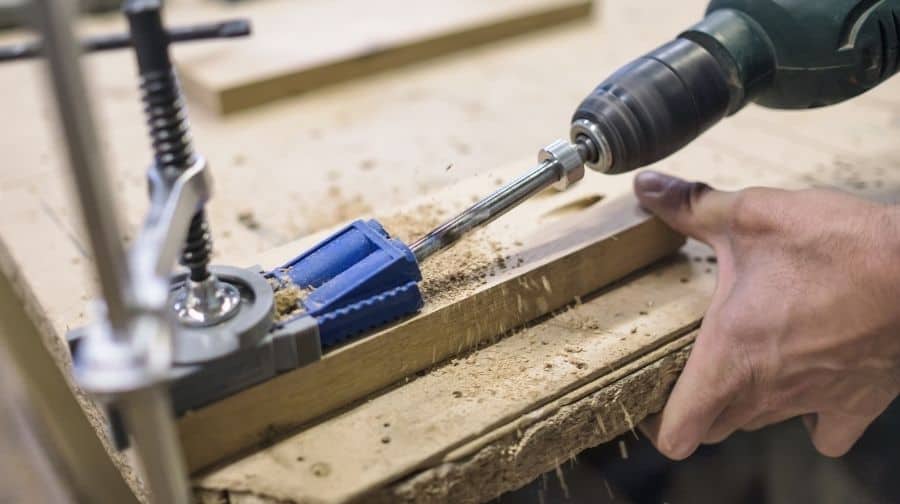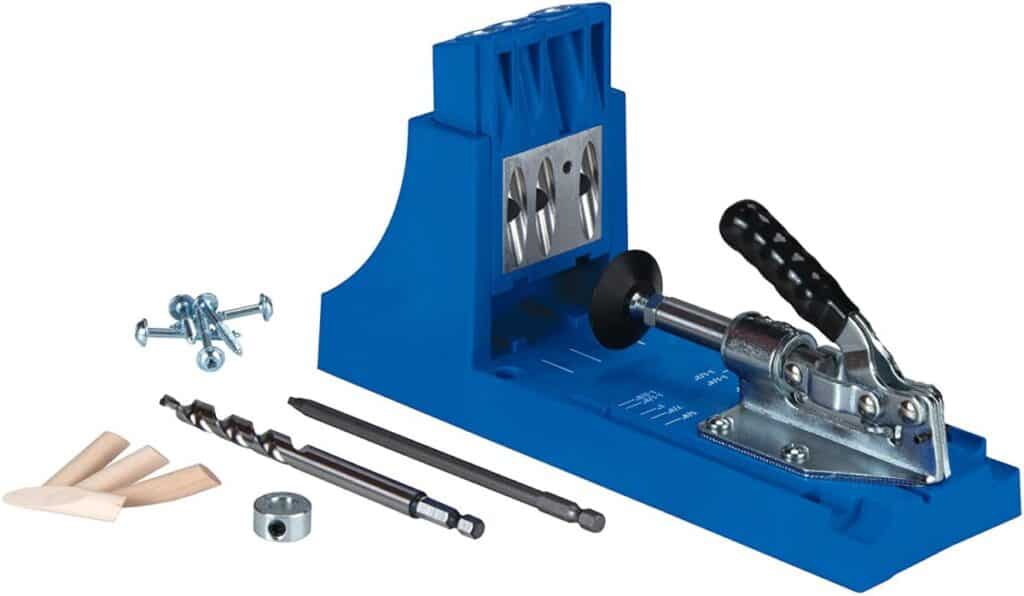
A pocket hole joint is a reliable joint used by woodworkers that can support a larger amount of weight and is relatively easy to craft. There are so many varieties of wood joints you can use. Each style has a specific purpose and function that separates it from the others. It can be confusing for a beginner to understand what all of the woodworking joints do so I researched through the internet and put together a quick summary on what mitre joints are used for.
What is a pocket hole joint used for? Pocket holes are a relatively simple joint technique that can be used for a range of woodworking projects, such as making cabinets, joining stiles and rails of a face frame, joining any two pieces of wood, edge joining, joining leg rails and braces, attaching risers and treads to make stairs, picture frames, window jambs, door jambs, joining curves, creating decks, stair rails, angles, aprons, beveled corners, edge banding, and euro-style cabinets.
Keep reading below to get a more in-depth look on pocket hole joints and what they are used for.
What Is A Pocket Hole Joint Used For?
Pocket holes are a relatively simple joint technique that can be used for a range of woodworking projects, such as cabinet boxes, bed frames, and shelves. This joint method is used for pieces in which you can’t drive a screw straight through to the other piece of wood and you have to screw in at an angle, and this often happens when you are joining wood together at a right angle.
Pocket hole joints are relatively strong and are also easy to craft, which makes them beginner-friendly for people who are new to woodworking.
Let’s talk more about some common questions surrounding pocket hole joints.
Pocket Hole Joint Uses:
- Assembling face frames
- Building cabinets
- Making furniture
- Attaching plywood to studs
- Bed frames
- Shelves
One of the most versatile tools in any woodworker’s arsenal is the pocket hole joint. These joints can be used for assembling face frames, building cabinets, making furniture, and attaching plywood to studs.
How Do You Make A Pocket Hole Joint?
To make a pocket hole joint, you are going to need a drill bit with a stop collar attached to it. Using a pocket hole jig makes the job easier. Simply drop the drill bit onto the hole on the jig, and leave about a quarter-inch of space from the end of the drill bit to the built-in stop on the pocket hole jig.
Once your drill bit is set up, you can clamp the pocket hole job to the piece of wood. You can do this with a locking pliers clamp. Now that the wood is in place, you can drill the holes into the wood.
When your holes are drilled into the wood, you are ready to select screws for the joint. You want to make sure that you select the correct length so that the pocket hole joint is strong. Ideally, the screw should go as far into the wood as it can without poking out on the other side.
You also need to determine which type of screw you want to use, the options being a fine or coarse thread. The right type of screw to choose depends on which type of wood you are working with. Typically a fine thread will work better with hardwood such as oak or maple, and a coarse thread will work better for almost all other types of lumber, including plywood and softwoods.
When you have picked the right screw for your job, you can screw it into place by using a long square driver. Make sure that when you are screwing the pocket hole joint into place, you use a clamp to keep the two pieces of wood firmly in place because the pieces can move creating an uneven joint.
What Is A Pocket Hole?
A pocket hole is a small hole that is drilled at an angle into one board, which will then join with another board using a screw. This type of connection is very strong and is commonly used in woodworking and carpentry.
One advantage of using pocket holes is that they allow you to hide the screws. This can be important for aesthetic reasons or if you want the screw to be less visible.
Another advantage is that they are very strong and can provide a lot of strength to a joint. This is important for things like shelves or cabinets where you need a lot of support.
Beginner’s Guide To Pocket Hole Joinery
Subscribe to Steve Ramsey – Woodworking for Mere Mortals on Youtube
Are Pocket Hole Joints Strong?
Pocket hole joints provide superior strength and are a very reliable joint, which is why they are still very common. This strength has been proven through load tests.
A comparable joint to the pocket hole is the mortise and tenon joint. The pocket hole joint was able to withstand up to 707 pounds, whereas the mortise and tenon joint failed at just 453 pounds. The strong holding power of the pocket hole joint will always make it a viable option for woodworkers to rely on.

Should You Glue Pocket Hole Joints?
Since you are using a screw to keep your pocket hole joint in place, you don’t have to glue them. You do have the option to if you really want the maximum amount of strength, but it is not necessary, unlike with a mitre joint.
One benefit of gluing pocket hole joints aside from added strength is that it will help prevent the joint from opening up due to seasonal shrinking and swelling in the wood.
Where Do You Put Pocket Holes?
You have to place the pocket holes close enough to the jointed piece of wood so that the length of screws you are using can reach through enough and create a strong joint. When you are deciding on your placement, pick a spot where the screws can go through the second layer of wood as much as possible without poking through.
When using a pocket hole jig, there are three different holes that you can send your drill bit into. Which holes you use depend on how thick of a piece of wood you are working with. If you are using a 1” to 2” wide board, use the B and C holes. For boards that are 2” to 3” wide, use the A and B holes. Lastly, for boards that are 3” to 4” inches wide, use the A and C holes.
Click here to browse through Pocket Hole Jigs on Amazon.

Do I Need Pocket Hole Screws?
Pocket hole screws are a specialty screw made for pocket hole joints. It has a wide flat underside to its head that sits in the flat bottomed pocket. This type of screw will help the pocket hole joint work more efficiently and cover more surface area, creating a stronger bond.
Click here to browse through Pocket Hole Screws on Amazon.
Can I Use Pocket Holes On Plywood?
You can use pocket holes on plywood, you just need to be careful so that the screws do not poke through and become visible.
Make sure that you adjust your drill guide to the thickness of the piece of plywood you are working with, then once your drill guide is set, adjust your drill bit collar so that it is shallower than the thickness of the wood. Also, make sure to use coarse-thread screws, as they will work better for plywood.
Is A Pocket Hole Jig Worth It?
While it is possible to make a pocket hole joint without a jig, it is a lot easier to do it with a jig. Using a jig will also give you more consistency with your joints. Without a jig, you will have to work carefully and ensure that you don’t go too deep, thus screwing in too far.
Having to work very carefully will make pocket hole joints more time consuming and there will be more room for error without the jig. If you have a lot of pocket holes to make, you should strongly consider getting a jig, but they are not completely necessary to make a good pocket hole joint.
